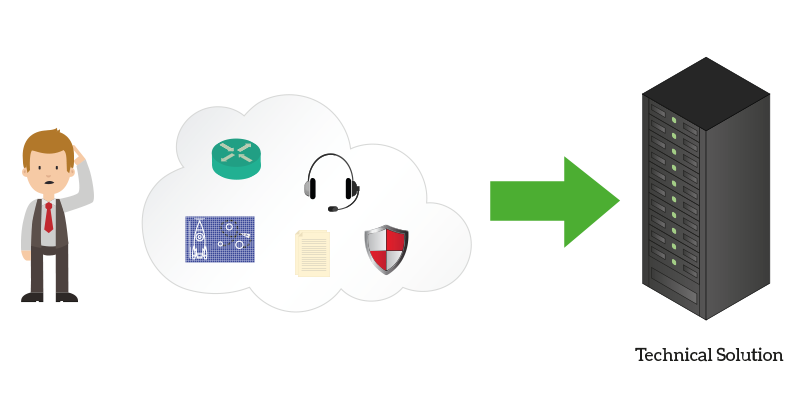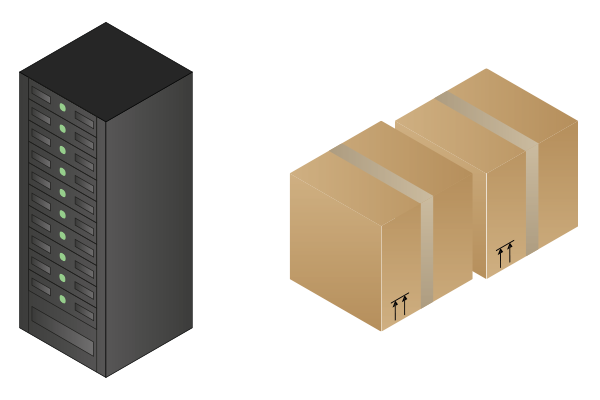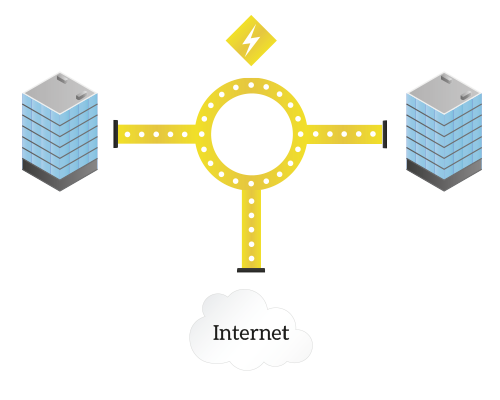We already know who is in charge of each specific task from the previous article. However, people work for companies: which company is in charge of doing what? In this article, we will explain just that, defining the three major types of companies you are likely to find when it comes to deploying an IT infrastructure: the vendor, the provider, and the system integrator.
The supply chain
In our fast-paced world, everything is made through some kind of supply chain and ICT makes no exception. In order to create an IT infrastructure starting from a concept, there are a lot of things to do. The right order of doing them might be not so obvious all the time. Before introducing the players mentioned above, let’s introduce the key company in the picture. The customer. As a customer, we simply mean a company that does not have ICT in its core business. Instead, the customer needs an IT solution to do business in a better way. From now on, we will refer to the company wanting a solution as “the customer”. And basically it goes this way: the customer has a problem, knows the pieces that have to be put together, but just does not know how (see picture below).

So, let’s clarify with an example. Suppose that the customer is going to open a new site in another city, or even in another country. The customer knows that the new site will need reliable access to key company resources. Generally, internal company resources are the billing system, Internet access, VoIP infrastructure to place calls internally for free, and so on. In other words, the customer has a need and has a very general idea of how to satisfy it. He might also know something about the technologies involved. He can guess the need for a firewall or a router, but he won’t go any further than that. Even if he knows something about the components, it is best if someone who is specialized in these technologies suggests the right move.
What is missing from the picture is someone who translates the customer’s needs into specific technical requirements that can be then satisfied by the implementation work technicians are going to do: this person is generally known as Technical Leader (to be generic). For example, the “I want Internet access all the time” business needs may be translated into the following technical requirements.
We need a fully redundant infrastructure with two in-line firewalls protecting two edge routers that are going to connect to two different ISPs, one primary with a flat offer and the other one billed on traffic volume. In normal operations, traffic should flow only onto the primary ISP.
If you haven’t understood what the previous statement was about, don’t worry. The key is that you understand how a simple “we need Internet” request can translate in a more specific and well-defined requirement – and this one wasn’t so well-defined after all! All in all, a customer will need someone to do this kind of translations between business needs and technical requirements, then someone else who can understand these technical requirements and can implement them. This means that this person has to know how to configure devices and such. This type of person knows very well a technology, he is the expert. However, he is limited to a specific set of technologies (nobody can know them all). To state what we already presented in a single sentence, we could say that Customer has needs, Technical Leader has requirements, Technician has solutions.
When we introduced computer networks, we presented a brief overview of what is In-house IT and what is outsourcing: now it’s time to go deeper because these two are the options the customer has when it comes to deciding who is going to do what about ICT.
In-house IT management
Let me put this straight for you: in-house IT management means that the customer has all the people needed to manage the IT infrastructure inside the company. Everyone is hired and paid by the customer directly. This could be a valid option in some cases and the worst choice of your business in other cases. Let’s see why.
For businesses starting quite small, like 1 to 20 employees, it is possible that no ICT support is needed at all. You can survive with a web-mail provider and with a traditional home-like internet connection. However, you will have someone who is a little bit more skilled than the other employees who will be in charge of purchasing laptops for other employees and eventually try to fix some of their problems. These tasks are a plus to his “normal” role, therefore he will have to subtract some time from its daily job to manage this small IT infrastructure. Not the best solution, but your business can certainly cope with it.
At this point, you might think that in-house IT management is free at this very basic level. And technically it is, however you have to keep in mind that you are paying a person who normally would be doing something else to do IT, so you don’t pay him for this something else at least some hours each week. So, if this something else is more costly and produce more revenue, you are wasting the talent (and the revenue) of this person.
But let’s say your business grows up to 50 employees. Now the person who also manages IT has too much work to do in order to maintain its current job, so it’s time to hire someone else. This person knows IT at a good level, he is not a specialist but instead, he can do a little of everything, that’s exactly what you need in your situation. This newly hired employee will be the one working on ICT all the time, he will purchase, troubleshoot, and repair your IT infrastructure.
The major drawback of the previous situation is that the person you hired is not a specialist. He’s cheaper, obviously, but his skill set is limited. As soon as your business grow again to mid-sized business, you will need to find another solution. And the critical situation is exactly when it comes to mid-sized businesses, like the one with several hundreds of employees and several million in yearly revenue.
You reach a point where your “IT guy” is not enough, not because he has to manage many more employees, but because other elements enter the picture, such as securing the Internet access, or servers remotely accessible, internal mail system, a VoIP solution and so on. You can quickly address this problem by hiring a more specialized guy alongside (not instead of) the other one. This way, you can have the less skilled one dealing with simpler tasks, while making the expense to maintain the other one worth it (because he will be managing only complex problems).
Unfortunately, you will arrive at a certain point where this is not enough. Your IT infrastructure is getting bigger and bigger, the complexity increase, and also the business needs. Soon enough, you will need to have some specialists: one for security, another for VoIP, another one for network, and so on. In order to optimize their work, you will also need a technical leader coordinating them. This is very costly and can be cost-prohibitive for mid-sized businesses. However, putting together a similar IT staff has a major benefit: he can manage a big, huge, and even extremely huge infrastructure. This solution will make you save money when your business grows again, but in the beginning it could be very expensive. The following picture shows just that.

You can guess – the alternative, which is cheaper most of the time, is outsourcing IT. But, how does that work? Let’s find out with the same example company in the following section.
Outsourcing to a system integrator
We already know a definition of outsourcing, so let’s bring the system integrator in the picture with the following definition.
A system integrator is an ICT company of specialists and technicians. Its core business is taking care of the ICT infrastructure of other companies (customers).
Fair and simple enough. You pay a system integrator to have your ICT infrastructure always running and up-to-date. In this section, we will disclose how exactly customers interact with their system integrators and what system integrators do for customers.
Let’s use the previous example of the growing company. Again, you start small with 1 to 20 employees. You want first-class IT from day-zero, so you contact a system integrator. At this point your budget for IT is limited, so you will search for a basic plan, almost off-shelf. At this point, you are generally looking for two things: the possibility for users to contact a basic and generic IT support for simple tasks such as configuring emails, setting up printers and so on – and the fact that the system integrator will engage the Internet provider when the Internet goes down.
Different types of contracts are around and, for this situation, the best option is to pay each time you make a support request since we do not expect tons of requests.
Once the company grows to 50 employees, and you start to have a few floors in a building, you might want to ask your system integrator to set up your network. This is a one-shot thing, you pay for the implementation, they come and configure. Then, the network to serve each and every one of your employees. After that, you continue to pay for each support request just like before. At this point, you are already saving money, but the key concept is not that. The cool thing is that you don’t have to know anything about IT. You just say “I need Internet access for everyone” and they do it for you, they take care of all technical requirements.
The company gets bigger and bigger and you can start to add services in a “pay-as-you-grow” way. For example, your system integrator can start to replace the broken devices for you. But we can go further than hardware replacement. You can even say “I want all the infrastructure to be running and up-to-date, supporting my business growth”. Instead of hiring your own engineering, you pay a flat fee and the system integrator upgrades the infrastructure each time needed. You don’t even have to know when it’s needed, they monitor it and define that for you! With a system integrator, the IT infrastructure can grow steadily as business grows.
How does the system integrator accomplish a cheaper cost than in-house IT? It’s simple: a system integrator has many technical people, and many of them are specialists. However, they are not sitting to wait for a customer to generate business for them. Instead, they work on different customers so that their cost is worth it for the system integrator. The customer does not have to pay for a specialist in a 9-to-5 formula. This translates in a less-expensive solution, as the following picture shows.

As in the picture, when you outsource IT a good option is to keep your local IT-manager for simple tasks. These tasks might be checking if something is powered on or plugged in. You still want to hire the IT manager because it is cheaper than having the system integrator send you a technician every time. And it isn’t just cheaper, it’s also faster (the local IT manager is already there).
Now, in order to configure your network and systems, you can use your own staff (In-house IT) or a system integrator. But where do these devices come from? In this next section, we will present the company producing hardware and software that you have to configure to suit your needs: the vendor.
The vendor
There are some companies producing the hardware and software out there. You can think of the vendor as a manufacturer, but it does much more than that. Before everything else, let’s clarify the definition.
A vendor is a company producing hardware and software goods for the implementation of ICT solutions.
So, at this point, you might think – if it produces and sells goods, how a vendor would differ from a normal manufacturer? The difference is a well-defined product support life-cycle that the vendor offers on its products. Let’s say you buy something from a vendor and something in the hardware goes broken after a few years. They send you a replacement component. Moreover, if you find a bug or have problems in using the product, you can contact the vendor (technical term: open a case to the vendor). They will help you and eventually fix the bug.
This, however, comes at a price: products from a top vendor are much more expensive if compared to a product with almost no warranty. Moreover, each product comes with a defined Mean-Time Between Failures (MTBF) which means “expect this product to stop working X years from now”, where X could be 5, 10, or even 20 years. This way, you can predict the behavior of your network and act accordingly.

Since vendors are the ones producing technologies, they are the ones defining it. Think about that, you learn and configure what they invented or – at least – implemented. For a vendor to be competitive, it must produce modern technologies at a good pace while keeping reasonable prices. In the following list, you will find some of the top vendors in ICT.
- Cisco, Juniper, and Huawei – these three are the ones producing network devices: devices interconnecting other devices. Cisco has been the market leader for 30 years. It produces also Voice over IP (VoIP) technologies and, at a minor scale, security products.
- EMC2 – this company is the leader for data center technologies (storage mainly). Among other companies, it owns VMware, one historical leader of server virtualization technologies.
- Citrix – a competitor of VMware in the virtualization technologies.
- Palo Alto, CheckPoint, Fortinet – vendors specialized in firewalls and network security.
- Microsoft, Red Hat Enterprise Linux – They both started selling an operating system (RedHat actually sells the support for it, since it is a Linux distribution). Microsoft now sells a lot of applications (Office, SQL Server…).
- Oracle, NetApp – specialized in data storage
- Amazon Web Services, Google Cloud – sell the “cloud”, in other words, a pool of resources to run your applications in their data centers.
- F5 – company specialized in load-balancer, network devices designed to distribute traffic among other devices.
- Hewlett Packard, Dell, Lenovo – they produce (among other things) servers and computational resources.
Now that we presented the vendor, the one producing hardware and software, we will present the service provider – the one connecting it remotely. After that, we will be able to see their similarities.
The Service Provider
Yes, the name seems pretty obvious: the service provider is the one providing services. Clear enough, but what services? Generally, as a service provider, we mean an Internet Service Provider (ISP), which does these two main things.
An ISP is a company using its own network to connect customer’s sites to the Internet and between each other.
In other words, you pay a periodic fee to your ISP and then you can connect to its network. You will transit on it to reach the Internet or the other sites of your company (if you connect them too). This is very helpful and cheap. It is very expensive to run cables under the streets, so connecting your sites would be cost-prohibitive otherwise.
You generally trust your ISP, meaning that you send your traffic “as is” to them. This implies that they can listen to it. However, for deployment needing security, you can always implement encryption to make this traffic readable only to your company. Given that, the network of the ISP is always the same at a physical level. On it, the networks of multiple customers run, divided from each other logically/virtually. This means that your company will share a physical wire with thousands of other companies, but the traffic flowing on it will never get mixed. This is achieved with some technologies such as MPLS or vnet trunking. These technologies are way out of the scope of the article. Because of its nature of letting use its own network to others, the ISP’s network is a transit network.

Another really cool thing about the ISP is that you don’t have to know how its network works. Instead, you just connect to it, and almost all the time you send everything through it. They will take care of that traffic for you. You can rewrite the same statement as simple as that: the ISP takes care of almost all of the routing.
Another cool thing that you can achieve is redundancy and fault tolerance. Should something fail, your site won’t lose the connection. In order to do that, we need to have everything doubled. It’s simpler than you might think. Picture your home router: it’s just one, meaning that if it breaks you will have to wait until another one is shipped to you. In the best case, you have an outage of a few hours, in the worst cases of a few days. Let’s say that you have another identical router in your garage: that’s a spare. If the one in place fails, you will replace it in a few minutes once you are ready.
What if it happens in the middle of the night? If nobody knows, the outage will last several hours until someone finds that out. This could be more than acceptable for a home environment, but it isn’t for an enterprise environment. You want a hot backup, with an outage in the proximity of zero (at most a few milliseconds). How can you accomplish that? Well, you need to have two routers powered on and connected to the ISP with two different cables. This solution is called dual-homed. But what if the entire ISP fails? It is a remote event, but it could happen. If you want to protect also from that, you should connect one of your routers to an ISP and the other one to another. This solution is called dual-multihomed.
Now that we ensured the availability of our network with redundancy and fault tolerance, we can take care of something else. The connection: throughput and latency. The throughput defines how much data can your connection carry in a fraction of time (generally a second is used). The latency how much will it take to your data to traverse the connection (get to the other side of the cable), and it’s measured in milliseconds. You can also consider other measurements, such as jitter. Jitter is the difference between minimum latency and maximum latency, it is crucial for VoIP traffic.
Regardless of measurement chosen, you a contract with your ISP contains some Service Level Agreements (SLAs). With that, you agree with your ISP that the service may go down to a certain level. However, if it stays below that for more than a specified amount of time you get a partial refund. That refund can increase as the outage increases, depending on the arrangement you have. All set, you are protected against everything now!
And after we disclosed all the secrets of the ISP, it’s time to present you the magic place where a service provider may be a system integrator, but also a vendor: the cloud.
The blurring edge
Technology – in all fields – is going in a single direction: integration. Technologies that were distant between each other are now the same thing. Think about phone calls. Less than two decades ago each desk had a network cable for data to the computer and a phone cable for the desk phone. Today, data and voice run over the same wire that goes into the phone and then into the PC. Amazing, isn’t it? This approach can fit in every situation, and vendors are adopting it on several technologies. What makes that possible? The cloud.
The cloud is a remote group of computational resources that are not given to you in their raw form, but instead, they are customized and given to you in the form of a product. Think of it this way, If you used to pay to own the truck, now you pay to get the delivery.
Let me give you an example. Talking about wireless, we have two major items: the Access Point (where you connect your devices) and the Wireless LAN Controller (WLC), a device that coordinates all the APs in a company. The traditional way of deploying it is purchasing a WLC and attaching it to your network. Instead, Cisco presented Meraki. With this technology, you don’t need to purchase the WLC anymore. Instead, Cisco controls your Access Points remotely. You can log in to a dashboard, tune and view everything you need. You don’t store all the information in your network anymore, it is in Cisco’s network. This is the cloud.

There are some concerns about the privacy and the integrity of your information when adopting public cloud. However, let’s face it: it brings to the table endless possibilities that foster the development of technology. But this makes you think, Cisco is not giving you a product, but it’s providing you a service. The vendor starts to merge into the service provider.
And now, it’s getting quite popular for the ISP to be the system integrator. Basically, an ISP goes to a possible customer to make an offer. If once we used to hear offers for connectivity, now we hear offers for connectivity and management of the internal network. Everything will be taken care of by the ISP, you don’t even have to worry about power outages.
They may offer solutions where some data are stored in your local network and some in their data centers or not. These hybrid solutions depend on your needs and on the ISP offers. However, not all ISPs have an army of technicians dedicated to customers’ internal networks, so they contact third-party system integrators. You will find employees of an ISP working alongside system integrators’ employees for the same task. Not enough? Many vendors have a consulting department that, in short, is a system integrator.
All in all, no matters what’s the title on the business card: there are three major categories of jobs. Manufacturing products, delivering services, and integrating everything together. These tasks can be identified with a vendor, a service provider and a system integrator. This article walked you through these different environments, explaining also what’s a likely direction for the future.
